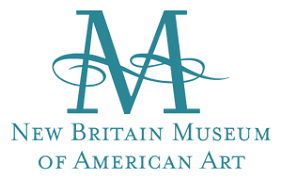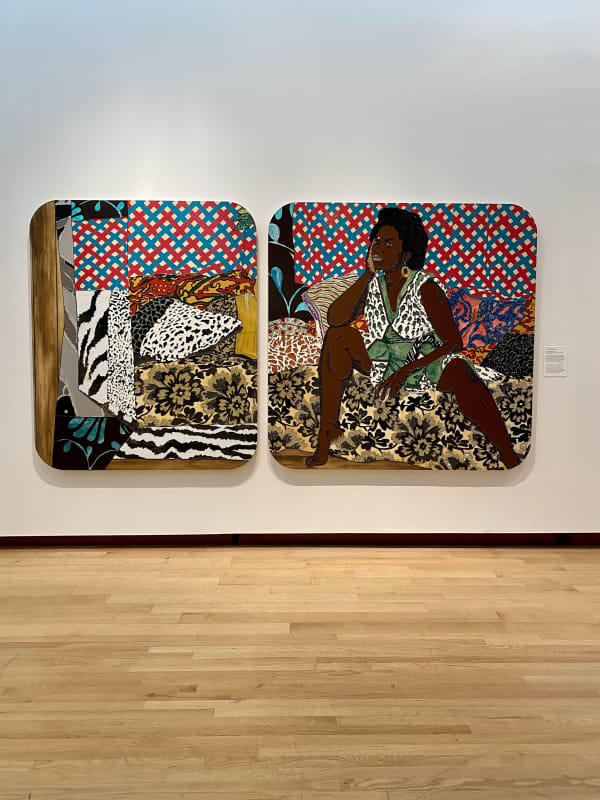Mickalene Thomas in 30 Americans: New Britain Museum of American Art, New Britain, CT
Drawn from the acclaimed Rubell Museum in Miami, Florida, 30 Americans showcases works by some of the most significant artists of the last four decades, including Jean-Michel Basquiat, Mickalene Thomas, Kara Walker, Hank Willis Thomas, and Kehinde Wiley.
This groundbreaking exhibition tells the story of Black humanity through the gaze of contemporary Black artists. Dating from the 1970s to the 2000s, the extensive group of paintings, drawings, collages, photography, portraiture, sculptures, installations, and performance artwork addresses over 200 years of American history and considers the powerful influence of artistic legacy and community across generations. The exhibition invites us to confront the complexities of individual and collective self-making; explore the transformative paths of self-determination and self-healing; reclaim dignity and liberation of the Black body and Black sexuality; and reframe the past, present, and future of African-descended people through wonder and imagination.
Curated by scholars Dr. Dann J. Broyld, Provost Nicole Stanton, and Dr. Brittney Yancy, the exhibition is a catalyst for community and conversation, and engages active collaboration with Museum staff and a 30 Americans Community Advisory Group comprised of local community members.
30 Americans at the NBMAA:
What does freedom mean? What does it mean to be Black + American? What is Blackness? are questions these 30 African American artists answer through reality, truth, imagination, and wonder. These questions are further explored by guest curators Dr. Dann J. Broyld, Nicole Stanton, and Dr. Brittney Yancy, and are interpreted through a series of unifying themes:
“Making a Way Out of No Way: Radical Black Self-Making in Contemporary Art”
“Making a way out of no way” is a phrase that emerges out of Black communities to express the challenges of surviving and thriving in the face of economic, aesthetic, cultural, and political oppression experienced in the Black diaspora. From food to fashion, performance to visual practice, Black communities have found ways to weave forms of expression that imaginatively reach towards liberation and self-determination. The artists in this section build on that tradition as they radically imagine, reinvent, and celebrate Black identities. They grapple with questions of race, subjectivity, gender, beauty, and power and invite the consideration of how we might rupture past stereotypes, opening up a multiplicity of possibilities for self-identification, liberation, and states of wonder.
Artists like Kehinde Wiley upend our expectations by placing contemporary Brown and Black people in settings associated with a white historical past. His figurative works quote historical sources and position young Black men in fields of power and, in doing so, disrupt our understanding of that past and Black and Brown subjectivity. Works by John Bankston conjure fantastical yet clearly racialized images that explore personal identities, and inner landscapes made tangible. These artists speak what is often unspoken, such as Robert Colescott, who takes on racial stereotypes and other cultural tropes through a visual language that challenges, surprises, and provokes.
William Pope.L’s work tackles the language of racism, racializing, and classification, probing identity through unexpected juxtapositions of text. He says of his work: "My focus is to politicize disenfranchisement, to make it neut, to reinvent what is beneath us, to remind us what's to come..." From the unexpected and self-proclaimed absurdities of Pope.L, we move polyrhythmically to the work of artists like Mickalene Thomas. She probes Black women’s beauty, sexuality, and experience, creating worlds where our ways of being are explored, elevated, and commemorated. Thomas is a multidisciplinary artist who creates spaces in which Black women see themselves and can imagine new possibilities. New signs. New Wonders.
“Signs and Wonders”
In this exhibition section, be raptured by wonder, step into a realm of marvel, where ancient alignment awaits new prospects. “Signs and Wonders” is a colloquialism or turn-of-phrase used in the African American community to describe both spiritual and space-like acts that occur with enchantment. They captivate and awe us into amazement, enlightenment, and illumination. Make us look to the Gods, constellations, and spiritual realm for explanations. They dazzle us with delight and leave us dazed in stardust. These acts open us to the possibilities and coloration of liberation, self-determination, and the wide world of signals, mirrors, and miracles. Mark Bradford, Jean-Michel Basquiat, and Glenn Ligon are just a few of the artists whose abstract compositions conjure these ideas.
Are the zodiac signs reflected in the whimsical works of the artist? Has art been influenced by the sun, moon, and the Milky Way? Can stars and earth’s orbit be held within us and the artist, as a replication of the heights and the adornment above? Have you searched your inner constellations to seek revelations? Enter this museum space open to messages asserted by the planets, and exit in a world of deep astrological exclamations! Turn upward bound, and endeavor to never let the artist be grounded in gravity’s grasp. Gather in this gallery the embellishment of the galaxies. In each art piece, search the zodiac signs for a clue higher than the present and the ether.
“Black Wonderment and Freedom Dreams: Adornment, Identity & Freedom”
Wonderment, Afrofuturism, materiality, and adornment present artistic visualities that reclaim Black humanity, reimagine freedom, and restore Black identity and culture to our everyday world. Historian Robin D.G. Kelley reminds us that imagination has the power to transform society, and in his work Freedom Dreams: The Black Radical Imagination, artists, in particular, transport us towards a free world. The artists in this section demonstrate how the practice of wonderment and imagination are embedded in the African diasporic experience; the ancestral spirit of faith, resilience, and imagination is rooted in the African tradition and spans generations across the diaspora. These artists are freedom dreamers who envision a world shaped by liberation, empowerment, and full personhood. Black wonderment relies on a universal worldview that allows for self-definition, and the artists of 30 Americans, in particular, elevate the tradition of adornment and materiality in the self-making process.
In this section, artworks including Nick Cave’s Soundsuit, Lorna Simpson’s Wigs (Portfolio),Mickalene Thomas’s Whatever You Want, and David Hammond’s The Holy Bible, Old Testamentsend us to a world where the tradition of fashion and adornment are central to African Americans’ pursuit of self-definition and freedom making. These works in this section invite us to confront the complexities and fluidity of individual and collective self-making; explore the transformative paths of self-determination and self-healing; reclaim dignity and liberation of the Black body and Black sexuality; and reframe the past, present, and future of African-descended people through wonder and imagination.






